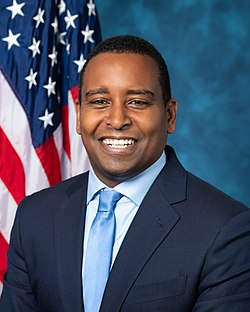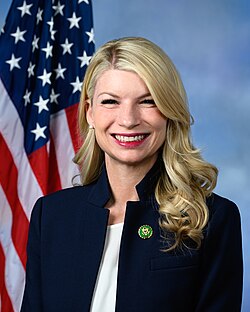Top Qs
Timeline
Chat
Perspective
United States congressional delegations from Colorado
From Wikipedia, the free encyclopedia
Remove ads
Remove ads
Since Colorado became a U.S. state in 1876,[1] it has sent congressional delegations to the United States Senate and United States House of Representatives, beginning with the 44th United States Congress. Prior to statehood, the Colorado Territory sent non-voting delegates to the House of Representatives from 1861 to 1876.[2] Each state elects two senators to serve for six years, and members of the House to two-year terms. Each state elects two senators to serve for six years in general elections, with their re-election staggered. Prior to the ratification of the Seventeenth Amendment in 1913, senators were elected by the Colorado General Assembly.[3] Each state elects a varying number of, but at least one,[4] member of the House, depending on population, to two-year terms.[5] Colorado has sent eight members to the House in each congressional delegation since the 2020 United States Census.[6]

A total of 80 people have served Colorado in the House and 37 have served Colorado in the Senate. The first of seven women to serve Colorado in Congress was Pat Schroeder, who served in the House from 1973 to 1996.[7] The first and only African-American to have served Colorado in Congress is Joe Neguse.[8]
The current dean, or longest-serving member, of the Colorado delegation is Representative Diana DeGette of the 1st district, who has served in the House since 1997.[9] She is the second-longest serving member of Congress in Colorado history, only behind Edward T. Taylor, who served in the House from 1909 to 1941.[10][11] Henry M. Teller, who served more than 30 years in the Senate,[12] is the longest-serving senator in Colorado history.[13]
Remove ads
Current delegation
Summarize
Perspective
Colorado's current congressional delegation to the 119th Congress consists of two senators, both of whom are Democrats,[14] and eight representatives comprising four Democrats and four Republicans.[15]
The state of Colorado gained an eighth congressional seat beginning in 2023.[16] The current dean of the Colorado delegation is Representative Diana DeGette of the 1st district, who has served in the House since 1997.[9]
The Cook Partisan Voting Index (CPVI) is a measure of how strongly partisan a state is.[17] It measures the party leaning (Democratic or Republican) and the number of percentage points more partisan than the national average. For instance, R+4 would mean the state voted four percentage points more Republican than the national average.[18] As of 2022, the CPVI ranked Colorado's 1st, 2nd, 6th, and 7th districts as leaning Democratic, and the 3rd, 4th, and 5th districts as leaning Republican. The 8th district is ranked as even.[19] As a state, Colorado is ranked as leaning Democratic, with a score of D+4.[20]
Remove ads
United States Senate
Summarize
Perspective
Two senators from Colorado, Henry M. Teller and Ken Salazar, have also served as the United States Secretary of the Interior, under the Arthur administration and Obama administration respectively.[27][28] Salazar is currently serving as the United States ambassador to Mexico under the Biden administration.[29] Many senators from Colorado, including John F. Shafroth and Edwin C. Johnson, also served as the governor of Colorado.[30][31] Some have also been at the forefront of national politics during their careers, including Eugene Millikin, who served as the chairman of the Senate Republican Conference,[32] and Gary Hart, who finished second in the 1984 Democratic Party presidential primaries and was considered a frontrunner in the 1988 Democratic Party presidential primaries.[33]
Senators are elected every six years depending on their class, with each senator serving a six-year term, and elections for senators occurring every two years, rotating through each class such that each election, around one-third of the seats in the Senate are up for election.[34] Colorado's senators are elected in classes II and III.[35] Currently, Colorado is represented in the Senate by Michael Bennet and John Hickenlooper.[36]



Democratic (D) Republican (R) Silver Republican (SvR)
Remove ads
United States House of Representatives
Summarize
Perspective
Many representatives from Colorado have played important roles in the House of Representatives, including by chairing congressional committees. For instance, Wayne N. Aspinall chaired the United States House Committee on Natural Resources from 1959 to 1973,[53] and Edward T. Taylor chaired the United States House Committee on Appropriations for more than three terms.[11] Taylor was also influential in the passing of the Taylor Grazing Act of 1934, which is named after him.[54] Others took on important roles later in their careers, such as John F. Shafroth, who later became the governor of Colorado and a senator from Colorado known for his influence over the passing of the Federal Reserve Act of 1913.[30] Seven women have served Colorado in the House, the first being Pat Schroeder,[7] and the first and only African-American to have served Colorado in the House is Joe Neguse.[8]
Each district uses a popular vote to elect a member of Colorado's delegation in the House of Representatives.[4] Districts are redrawn every ten years, after data from the US Census is collected.[55] From 1861 to 1876, Colorado sent a non-voting delegate to the House of Representatives; when it became a state in 1876, it had one seat in the House. Since then, its representation in the House has grown along with its population. Since 2023, Colorado has had eight congressional districts drawn according to the results of the 2020 United States Census.[2][16]



1861–1876: 1 non-voting delegate
Starting on August 19, 1861, the Territory of Colorado sent a non-voting delegate to the House.[2]
Democratic (D) Republican (R)
1876–1893: 1 seat
Following statehood on August 1, 1876, the state of Colorado was apportioned one seat in the House.[2]
Democratic (D) Republican (R)
1893–1903: 2 seats
Following the 1890 census, Colorado was apportioned two seats.[2]
Populist (Pop) Silver Party (Sv) Republican (R)
1903–1913: 3 seats
Following the 1900 census, Colorado was apportioned three seats.[2]
Democratic (D) Republican (R)
1913–1973: 4 seats
Following the 1910 census, Colorado was apportioned four seats.[6]
Democratic (D) Republican (R)
1973–1983: 5 seats
Following the 1970 census, Colorado was apportioned five seats.[6]
Democratic (D) Republican (R)
1983–2003: 6 seats
Following the 1980 census, Colorado was apportioned six seats.[6]
Democratic (D) Republican (R)
2003–2023: 7 seats
Following the 2000 census, Colorado was apportioned seven seats.[6]
Democratic (D) Republican (R)
2023–present: 8 seats
Since the 2020 census, Colorado has been apportioned eight seats.[6]
Democratic (D) Republican (R)
Remove ads
See also
Notes
- Senator Teller resigned in 1882 to become the Secretary of the Interior in the Chester A. Arthur administration. He later returned to the Senate in 1885.[38][27]
- Senator Chilcott was appointed to serve in the open seat created by Teller's resignation.[39] He served until Horace Tabor was elected in the 1883 United States Senate special election in Colorado to complete the rest of the term.[40]
- Senator Teller became a member of the Silver Republican Party in protest to the silver policies of the Republican Party.[41]
- Having already switched to the Silver Republican Party, Senator Teller decided to seek reelection as a member of the Democratic Party, instead of the Republican Party, as silver became less of an issue in politics.[42]
- Senator Hughes died in office.[43]
- Senator Nicholson died in office.[44]
- Senator Adams was first appointed to the role of Senator on May 17, 1923, to serve in Nicholson's seat[45] until Rice W. Means was elected in a special election.[46] He later returned to the Senate in 1933.[45]
- Senator Waterman died in office.[47]
- Senator Walker was appointed by Governor William Herbert Adams on September 27, 1932, to serve in Waterman's seat[48] until Karl C. Schuyler was elected in a special election.[49]
- Senator Adams died in office.[50]
- Senator Campbell switched from the Democratic party to the Republican party in 1995.[51]
- Senator Salazar resigned in 2009 to become the Secretary of the Interior under the Obama administration.[52]
- Representative Shafroth resigned, believing that he had won the 1904 United States House of Representatives election in Colorado because of election fraud, giving up his seat for his opponent, Robert W. Bonynge.[58]
- Representative Taylor died in office.[11]
- Representative Vaile died in office.[59]
- Representative Lewis died in office.[60]
- Representative Martin died in office.[61]
- Representative Lauren Boebert decided to move to the 4th District after the resignation of Ken Buck.
- Representative Ken Buck resigned on March 22, 2024, before the end of his term.[62]
Remove ads
References
Wikiwand - on
Seamless Wikipedia browsing. On steroids.
Remove ads


















